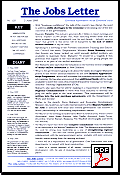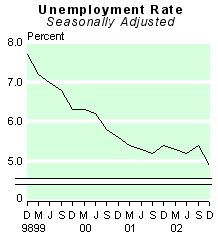



|
 |

|
| No.180 | 17 February 2003 | Essential Information on an Essential Issue |
of key events over the last few weeks. STATISTICS THAT MATTER BREAKING THE 5% BARRIER WHO'S GOT THE JOBS?  LAST Letter
LAST Letter
NEXT Letter   Download this issue as a PDF file
Index to Features
Minister of Tertiary Education Steve Maharey says that the government will be setting maximum tertiary course fees so that students and their parents will know when they start a course what the overall cost will be. Maharey also says a review of the student loan and allowance schemes will be completed by June and is likely to recommend a wider range of students will be eligible for the student allowance.
The government initiates a student levy and a tax on tuition and course fees on institutions that provide teaching services to fee-paying foreign students. While the money is earmarked for industry development, The Independent comments that no such industry development taxes apply to any other export industry.
Legislation Direct, previously the Government Printing Office, closes its doors after 136 years as printers to the government.
Builders are struggling to meet demand as building consents reach a 16-year high. The Master Builders Federation says that the shortage of tradespeople is commonly causing delays of six months for work to start on a new house.
International equity funds devalued by 28% last year. For NZ investors this translates into a $1.5 billion devaluation of their international fund investments.
A promising catch of Omega prawns has raised hopes of a prawn processing industry in the South Island. Vela Fishing manager Chris Ludeke speculates that a South Island prawn industry could employ 200 people.
Dow Chemical announces new international job cuts of between 3,000 and 4,000 people.
Council of Trade Unions president Ross Wilson calls for schemes to provide unemployed workers with the skills to enable them to fill the shortages in the labour market.
100,000 activists, NGO campaigners, academics and trade unionists from more than 130 countries attend the third World Social Forum in Brazil. The Forum is held as a people-based alternative to the World Economic Forum attended by finance and business leaders in Switzerland.
NZ companies devote just over one day a year to training their employees. Globally, businesses provide three days training per year according to PriceWaterhouseCoopers.
The National Party caucus outlines social policy changes it is considering. These include putting time limits on benefits, requiring beneficiaries to have their children immunized, and resurrecting work-for-the-dole.
The Engineering Printing and Manufacturing Union calls for employers to invest more in training. Union secretary Andrew Little says that while workers welcome pay rises, they also want to see the long-term viability of their jobs and industries strengthened through a well trained workforce.
The Ministry of Social Development says it will help sheltered workshops meet their obligations when disabled staff are no longer exempted from minimum wage and holiday provisions.
Last year, for the first time, annual tourist numbers to NZ topped 2 million.
WorldCom, the US company that last year filed the world’s largest bankruptcy application, says it will cut staff by 5,000.
Economists say the US economy is holding its own but is not creating jobs. Royal Bank of Scotland economist Ram Bhagavatula says that US manufacturers are making more with fewer people.
While inflation rose 2.6% last year, on average, workers pay rates rose by only 2.1%. According to Statistics NZ, 43% of NZ workers had no rise in pay at all.
The number of hours NZ’ers worked last year increased by 3.9%.
An OECD report claims NZ has the highest youth suicide, offending and cannabis use rates of the 31 countries measured. NZ’s Principal Youth Court Judge Andrew Becroft discounts the report as unreliable because it is based on six year old information and does not compare “like with like”.
The Consuming Industries Trade Action Coalition in the US says that the implementation of 30% tariffs on imported steel to the US last year cost 200,000 jobs in small US companies. The CITAC argues that these job losses exceed the number of people who work in the steel industry that the tariffs were meant to protect.
A Child Poverty Action Group survey finds that primary school aged children in poor families change schools at least once a year and this has a detrimental effect on their education. The survey identifies lack of home ownership is a major contributing factor to this transience.
German unemployment reaches 11.1%.
Job losses appear likely in Taranaki as the Maui gas field is estimated to have a shorter lifespan than expected. Major gas user Methanex has made no job cut announcements yet but says it will halve production this year.
The Social Entrepreneur Fund, designed to help foster community sector “champions”, is broadened beyond employment and economic development to include people who have backgrounds in youth, welfare, health and education. The fund is administered by CEG.
A Monash University report forecasts that 70,000 Australian workers will lose their jobs due to the most severe drought in Australia since European settlement.
The government publishes a list of 10 “guiding principles” it says it will follow as it reviews what new NZ service sectors it intends to offer up to global competition through signing a General Agreement on Trade in Services.
The Council of Trade Unions asks the government to put back the 31 March signing of a new GATS agreement. The CTU argues that because the government has yet to publish its position paper on the treaty, time will run out for public debate and submissions before the deadline.
Free medical healthcare clinics are now operating in 18 Waikato secondary schools. The scheme is an extension of free GP and counseling services provided to low- to medium-decile schools already operating in Rotorua, Gisborne and Wellington.
The cost to high school students of getting their National Certificate of Educational Achievement will rise to $150 starting this year. Some principals report that even at last year’s rate of $80 - $100, some students abandoned their NCEA credits because they could not afford to pay for the qualification.
The NZ unemployment rate drops to 4.9%, the lowest rate in 15 years. (see this issue)
The OECD apologises for misrepresenting NZ as having the highest youth offending and suicide rates. The OECD admitted it had not collected comparable information on youth crime from member nations. It also agreed that the published youth suicide rates were out of date .
 LAST Diary
LAST Diary
NEXT Diary 
|
BREAKING THE 5% BARRIER It’s the best employment news in fifteen years: we’ve broken the 5% barrier in our unemployment rate, and now have less than 100,000 people officially out-of-work. It’s the best employment news in fifteen years: we’ve broken the 5% barrier in our unemployment rate, and now have less than 100,000 people officially out-of-work. New Zealand has now had four and a half years of good job growth, with 165,000 jobs created since June 1998. — the official unemployment rate for the December 2002 quarter is 4.9%, after dropping 0.5% from the 5.4% rate last September. New Zealand was last below the 5% level in March 1988.
Sources – Statistics NZ Household Labour Force survey for December 2002; Press Release Steve Maharey 11 February 2003 “Government welcomes fall in unemployment”LONG-TERM TRENDSUnemployment Unemployment Rate Sources – Statistics NZ Household Labour Force survey for December 2002WHO’S GOT THE JOBS?— over a third (72,300 or 38%) of the new jobs have gone to Maori and Pacific people. Source – Statistics NZ Household Labour Force Survey for December 2002
MORE COMMENTS ON THE LATEST STATISTICS ...Infometrics senior economist, Tony Booth, believes however that the unemployment rate could also drop further — possibly to as low as 4.5% by the start of next year. Booth: “It depends to a great extent on how much migration stops. The government has taken some measures to tighten up on migrants coming in, in terms of English language requirements and so on ...” Wages are generally expected to start rising if unemployment remains below 5%, although they grew by just 2.1% last year compared to inflation of 2.6%. The economists surveyed by Dow Jones have commented that inflationary pressures from the growth in employment are being negated by the strong NZ dollar, and concerns about the world economy. Sources — Dow Jones Newswire 10 February 2003 “NZ jobs growth likely to remain robust in 4Q” and 11 February 2003 “NZ Jobs Data underline 1H Rate Cut unlikely”; NZPA 12 February 2003 “Unemployment rate falls to 15-year low” by Melanie Carroll.But CTU Economist Peter Conway says that the level of 98,000 people unemployed is still far too many given the strong demand for workers. Conway: “While in a dynamic labour market there is some unemployment as people move between jobs, there is clearly a contradiction when we have employers calling out for workers, but there are still nearly 100,000 out of work.” Conway says the answer lies partly in much better targeting of the training needs for the unemployed, and more assistance in the transition to work. Source – Press Release CTU Peter Conway 11 February 2003 “Still Too Many Unemployed – CTU”Newman points to official answers to her parliamentary questions which show that more than 42,000 NZ’ers, who are currently on the dole, have been paid benefits for more than two years. Newman: “ It is, therefore, deeply disturbing to discover that there are 37,000 New Zealanders who now appear to be missing. My question to the government is: where are they? They do exist. They are real people, who have been on benefits for more than two years — yet have not been incorporated into Government statistics...” Newman’s view is that the Labour government is “hiding behind the smokescreen of the Labour Force Household survey — which does not count people as unemployed if they are not actively seeking work, or have worked for more than one hour in the past two years.” Source – Press Release Muriel Newman 12 February 2003 “Government loses unemployed”AUCKLAND DRIVES JOB ADSThe ANZ job ads series reports that there is a growing dichotomy between job ads in Auckland and in the rest of the country. Auckland job ads were up 30.1% on levels prevailing at the same time last year. But all other regions, except Christchurch, have recorded a fall in job advertising levels over the year. ANZ Chief Economist David Drage: “After a period of robust growth, activity in some provincial centres has plateaued as the headwinds of a difficult international environment and recent strong gains in the Kiwi dollar feed through to rural incomes. To the extent that this has been reflected in job ad trends, the contrasting regional developments suggest that employment growth over the year ahead will be increasingly driven by Auckland…” Source – ANZ Job Ads survey for 12 February 2003 “Auckland to drive further employment growth” by David Drage
|
||||||||||||||||||||||||||||||||||||||||||||||||||||||||||||||||||||||||||||||||||||||||||||||||||||||||||||||||||||||||||||||||||||||||||||||||||||||||||||||||||||||||||||||||||||||||||||||||||||||||||||||||||||||||||||||||||||||||||||||||||||||||||||||||||||||||||||||||||||||||||||||||||||||||||||||||||||||||||||||||||||||||||||||||||||||||||||||||||||||||||||||||||||||||||||||||||||||||||||||||||||||||||||||||||||||||||||||||||||||||||||||